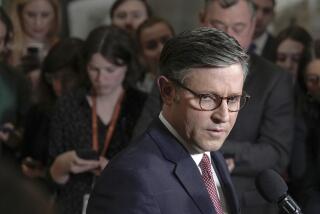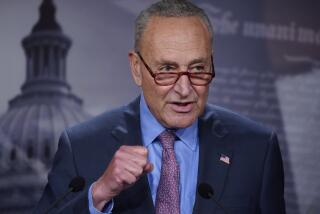Too little in return for stimulus plan
The $789-billion stimulus package being rushed through Congress is a decidedly mixed blessing. We welcome lawmakers’ focus on the recession, and we agree that the federal government can and should deliver a sizable jolt to the moribund economy. Among the final bill’s provisions are several with a strong record of stimulating spending, such as extended unemployment benefits and increased investments in highways and public transit. We also welcome farsighted proposals for promoting broadband Internet access, high-speed rail and a modernized electrical grid. But the version worked out by the White House and congressional leaders serves as a case study for the time-worn notion that haste makes waste.
The bill has three main pieces: $311 billion in discretionary spending, $287 billion in tax cuts and $191 billion in increased benefit programs, such as Medicaid. Scattered throughout each are proposals that advance a political agenda more than an economic one. These range from $2 billion in tax credits for purchasing plug-in electric cars -- none of which are on the market today -- to a $70-billion reduction in the alternative minimum tax, which is far less likely to increase consumer spending than, say, a similarly sized payroll-tax holiday. And in some cases, the increases expand programs that may be hard to trim after the crisis passes. A good example is the $13 billion in additional funding for Title I, which benefits schools serving low-income students. What’s worse, there are no accountability measures attached to those funds and no requirement to create jobs through the program, which has never been shown to improve student achievement. Finally, the bill contains a populist “Buy American” provision that recalls the worst protectionist impulses of the Great Depression.
Congress is certain to approve the current version of the bill, so it’s futile to hope for improvements. Instead, we urge state and local governments to make sure taxpayers get the biggest return for the dollars that Washington borrows. A report by Moody’s Economy.com last year noted that the most effective stimulus plans put money in the hands of those who have no choice but to spend it. The same report found that infrastructure projects were a good investment, but the “shovel ready” projects pitched by some communities simply aren’t worth building. To guard against construction projects that spend for the sake of spending, Brookings Institution urban planner Robert Puentes has offered a bit of sound advice to state and local officials: Put the infrastructure money they receive into repairs and renovations rather than new edifices. Such projects may not be flashy, but they’re more likely to be worth the money.
More to Read
A cure for the common opinion
Get thought-provoking perspectives with our weekly newsletter.
You may occasionally receive promotional content from the Los Angeles Times.










